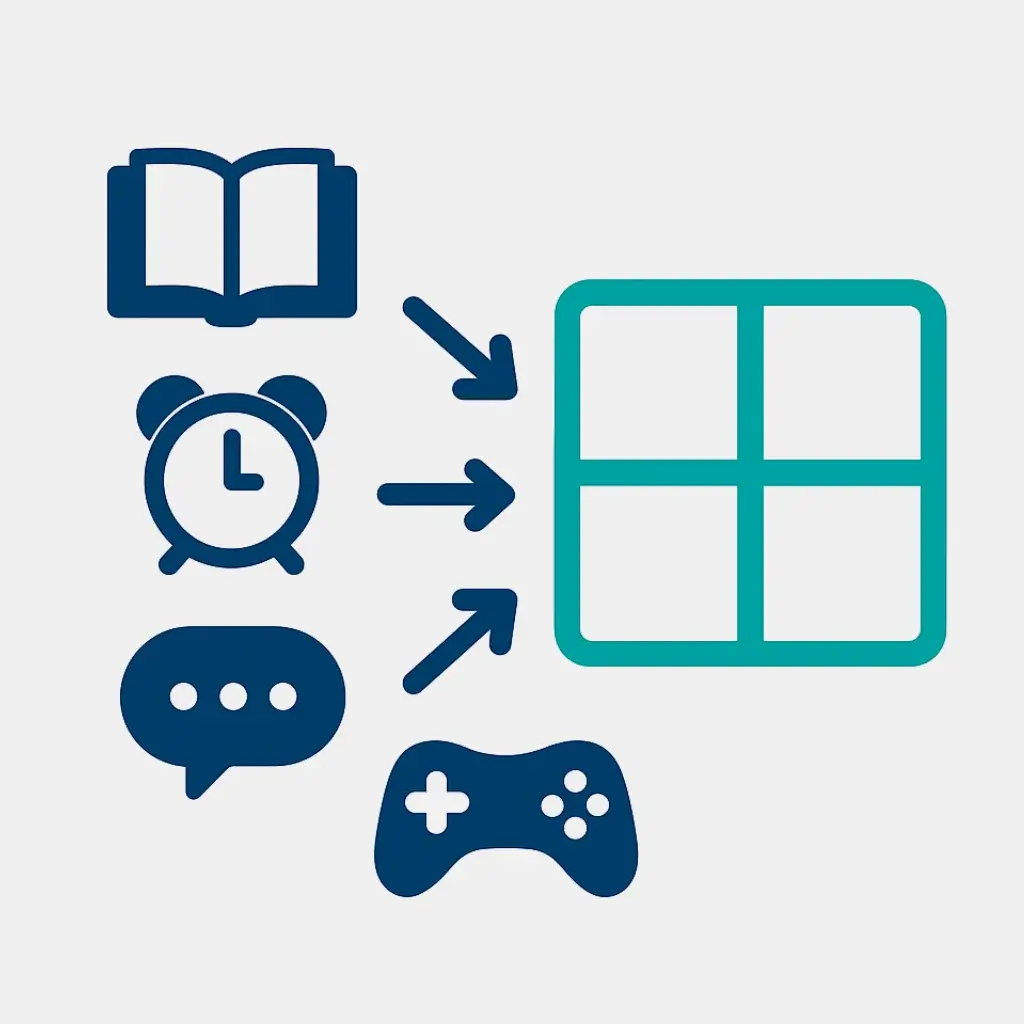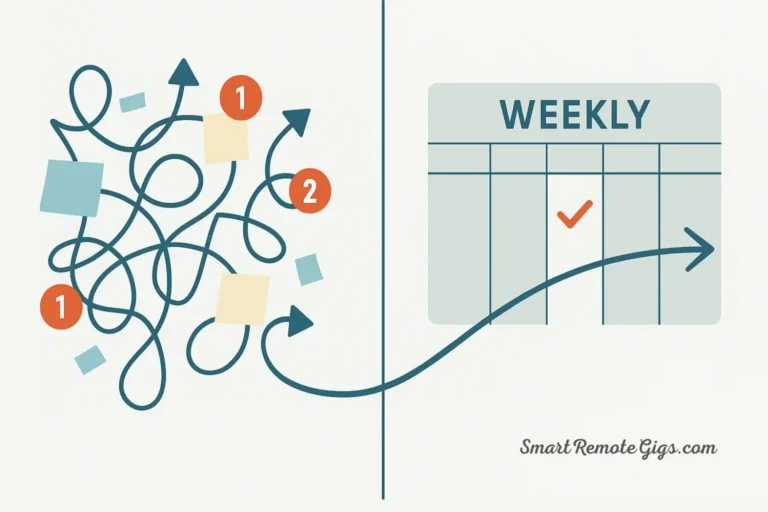It’s Sunday night. You have three assignments due this week, a midterm on Thursday, a group project presentation on Friday, and your friends just invited you to a concert tomorrow. Your calendar is a mess, your stress is through the roof, and you’re not sure where to start. Sound familiar?
Welcome to student life—a constant juggling act between urgent deadlines, important long-term goals, and the ever-present temptation to procrastinate. But what if there was a simple framework that could bring order to this chaos? Enter the Eisenhower Matrix for students—a powerful tool that helps you prioritize tasks, beat procrastination, and actually enjoy your college experience instead of just surviving it.
This guide will show you exactly how to apply this time management system to your academic life, with real examples you’ll recognize and a practical action plan you can start using today.
A Quick Refresher: What is the Eisenhower Matrix?
The Eisenhower Matrix is a prioritization tool that helps you organize tasks based on two criteria: urgency and importance. It divides everything on your plate into four quadrants:
Quadrant 1 (Do): Tasks that are both urgent and important—your crises and deadlines that need immediate attention.
Quadrant 2 (Schedule): Tasks that are important but not urgent—the strategic work that builds your future success but doesn’t scream for attention.
Quadrant 3 (Delegate): Tasks that are urgent but not important—distractions and interruptions that feel pressing but don’t move you toward your goals.
Quadrant 4 (Delete): Tasks that are neither urgent nor important—time-wasters that you should eliminate.
The magic happens when you learn to spend less time in Quadrants 1, 3, and 4, and invest more energy in Quadrant 2. For a comprehensive breakdown of how this framework works, including downloadable templates, check out our Ultimate Guide to the Eisenhower Matrix.
The 4 Quadrants of a Student’s Life (Real Examples)
Understanding the theory is one thing. Recognizing these quadrants in your daily student life is another. Here’s what each quadrant actually looks like when you’re balancing classes, exams, social life, and everything else.
Quadrant 1: Do (The All-Nighter Zone)
These are the tasks that have you pulling all-nighters and stress-eating in the library. They’re both urgent and important—you can’t ignore them without serious consequences.
Examples:
- Submitting an assignment that’s due tomorrow morning
- Cramming for a midterm exam happening in 24 hours
- Finishing your part of a group project due at midnight
- Writing a paper for a class that’s due this afternoon
- Studying for a quiz that’s happening in your next class
- Responding to a professor’s urgent email about your grade
- Registering for classes before they fill up (on the last day)
The Reality: If you’re constantly living in Quadrant 1, you’re operating in crisis mode. Your grades might be okay, but you’re stressed, exhausted, and not retaining much. The goal isn’t to eliminate this quadrant—some deadlines are inevitable—but to minimize how much time you spend here by being proactive about Quadrant 2.
Quadrant 2: Schedule (The A+ Student Zone)
This is where the magic happens. These tasks are important for your academic success and personal growth, but they don’t have tomorrow’s deadline attached to them. This is the quadrant of students who seem effortlessly successful—they’re not smarter, they’re just more strategic about prioritizing studying.
Examples:
- Starting research for a term paper that’s due in three weeks
- Doing weekly reviews of your class notes to solidify understanding
- Planning your study schedule for the semester
- Attending office hours to clarify concepts before they’re on the exam
- Building relationships with professors and mentors
- Working on skill development (learning a language, coding practice)
- Exercise, proper sleep, and meal planning
- Creating study guides throughout the semester, not just before finals
- Joining a study group that meets regularly
- Reading ahead in the textbook before lectures
The Reality: These activities don’t demand your attention right now, which is precisely why they get neglected. But here’s the truth: time management for college students who excel comes down to protecting time for Quadrant 2. When you consistently invest here, your Quadrant 1 crises shrink dramatically.
Quadrant 3: Delegate (The ‘Could Someone Else Help?’ Zone)
These tasks feel urgent—they’re pressing on you right now—but they’re not actually moving you toward your academic goals. As a student, true delegation can be tricky, but there are still ways to minimize time spent here.
Examples:
- Attending every single club meeting when you’re already overcommitted
- Responding immediately to every group chat message
- Running errands that could be combined or postponed
- Saying yes to every social invitation out of obligation
- Taking notes for a friend who skipped class (again)
- Doing more than your fair share in group projects
- Attending meetings that don’t require your presence
- Handling administrative tasks that could be done by someone else
How to Handle These:
- Set boundaries: You don’t have to respond to every text immediately.
- Trade tasks: If a friend needs notes, maybe they can proofread your paper.
- Learn to say no: Not every invitation or request deserves a yes.
- Use technology: Automate or batch these tasks when possible.
The Reality: Many students confuse urgency with importance. Just because someone needs something from you right now doesn’t mean it should be your priority. Quadrant 3 is where people-pleasers and the chronically busy exhaust themselves on other people’s priorities.
Quadrant 4: Delete (The Procrastination Zone)
Let’s be honest—we all know this quadrant intimately. These are the activities that provide temporary escape but move you exactly zero inches toward your goals. They’re neither urgent nor important, yet somehow they consume hours of your day.
Examples:
- Mindlessly scrolling through TikTok, Instagram, or Twitter
- Binge-watching an entire season when you have work to do
- Playing video games for hours “just to relax”
- Online shopping you don’t need to be doing
- Reorganizing your desk for the third time this week
- Attending parties the night before major deadlines
- Excessive napping when you’re not actually tired
- Starting a new show the week before finals
- Endlessly tweaking the formatting of an assignment instead of working on content
The Reality: Quadrant 4 often feels like a reward or break, but it’s actually a trap. There’s a difference between intentional rest (which is Quadrant 2) and mindless escape. The study planner matrix approach means ruthlessly cutting time here and redirecting it to activities that actually recharge you or move you forward.
Your 4-Step Plan for a Smarter Study Schedule
Knowing the quadrants is valuable. Using them consistently is transformational. Here’s your practical action plan to implement the Eisenhower Matrix for students starting this week.
Step 1: Weekly ‘Brain Dump’ – List Every Single Task

Set aside 20 minutes every Sunday evening (or whatever day works for your schedule) to do a complete brain dump. Write down everything that’s competing for your attention: assignments, readings, exams, social commitments, errands, workouts, even “do laundry” and “call Mom.”
Don’t organize yet—just get it all out of your head and onto paper or a digital document. This serves two purposes: it clears your mental clutter and gives you a complete picture of your week.
Step 2: Sort Into the 4 Quadrants

Now review each item and ask yourself two questions:
- Is this important? Does it contribute to my academic success, personal health, or long-term goals?
- Is this urgent? Does it have an imminent deadline or consequence if I don’t do it soon?
Based on your answers, place each task into its appropriate quadrant. Use the examples above as your guide. Be brutally honest—that “urgent” group chat isn’t really urgent, and that term paper you keep putting off is definitely important.
Step 3: Time-Block Your Quadrant 2 Tasks

Here’s the game-changer: schedule your Quadrant 2 tasks first, before anything else. Open your calendar and block dedicated time for the important-but-not-urgent work. Treat these blocks as non-negotiable appointments with your future self.
For example:
- Monday 2-4 PM: Work on term paper research (Q2)
- Wednesday 10-11 AM: Review lecture notes from this week (Q2)
- Friday 9-10 AM: Office hours with professor (Q2)
Then fit your Quadrant 1 tasks around these blocks. Handle Quadrant 3 tasks in the gaps, and eliminate Quadrant 4 activities.
This approach feels counterintuitive—shouldn’t you do urgent things first? But by protecting time for important work, you prevent it from becoming urgent later.
Step 4: Review and Adjust Every Sunday

Make this weekly review a habit. Every Sunday, look back at the past week: Did you spend time where you intended? What fell through the cracks? Are certain tasks repeatedly landing in Quadrant 1 when they should have been handled in Quadrant 2?
Use these insights to adjust your approach. Maybe you need bigger time blocks for deep work, or perhaps you’re saying yes to too many Quadrant 3 commitments. The matrix isn’t a one-time fix—it’s a practice that gets more effective the more you use it.
5 Common Student Traps to Avoid
Even with the best intentions, students often fall into predictable traps when using this framework. Here are the most common mistakes and how to avoid them:
Trap 1: Confusing Socializing with Studying
“Studying with friends” sounds like Quadrant 2, but if you’re actually just hanging out with textbooks open, it’s Quadrant 4. Be honest about whether an activity is genuinely productive or just procrastination with extra steps. A focused study group with a clear agenda? Quadrant 2. Meeting at a coffee shop where you mostly gossip? Quadrant 4.
Trap 2: Letting Peer Pressure Dictate Your Priorities
Your friend needs you to proofread their paper right now. Your roommate wants help with their problem set immediately. These requests feel urgent because someone else is pressuring you, but that doesn’t make them your priority. Learn to say, “I can help you tomorrow afternoon” or “Have you tried the writing center?” Setting boundaries isn’t selfish—it’s essential for managing your own responsibilities.
Trap 3: Treating Everything Like a Crisis
Not every assignment deserves an all-nighter. Not every exam requires cramming. If everything feels like Quadrant 1, you’re probably not accurately assessing urgency and importance. Step back and ask: “What happens if this doesn’t get done perfectly?” Often, you’ll realize that “good enough” on a low-stakes assignment is better than “perfect” at the cost of sleep and sanity.
Trap 4: Neglecting Self-Care as “Not Urgent”
Sleep, exercise, healthy meals, and genuine rest are Quadrant 2 activities, not luxuries. Many students push these aside because they don’t have deadlines attached, then wonder why they’re burned out and underperforming. Your body and mind are your most important tools—treat their maintenance as essential, not optional.
Trap 5: Using the Matrix Once and Forgetting It
The urgent vs important for exams distinction doesn’t become intuitive after one use. This framework requires consistent practice. Students who see the biggest benefit are those who make the weekly review ritual non-negotiable. Set a recurring reminder, tie it to an existing habit, and commit to the process for at least a month before judging its effectiveness.
Conclusion: Own Your Semester, Don’t Just Survive It
The difference between students who thrive and students who merely survive often comes down to one thing: intentionality. The Eisenhower Matrix for students gives you a framework for making deliberate choices about where your time and energy go.
You’ll still have deadlines. You’ll still have stressful weeks. But instead of reacting to whatever screams loudest, you’ll be proactively investing in the activities that compound over time—the Quadrant 2 work that separates good students from great ones.
The best part? This isn’t complicated. You don’t need fancy apps or productivity systems. Just a simple four-quadrant grid, 20 minutes on Sunday evenings, and the commitment to prioritize what’s important over what’s merely urgent.
Start organizing your tasks today and see the difference. Your future self—better rested, less stressed, and earning better grades—will thank you.
Ready to dive deeper? Check out our Ultimate Guide to the Eisenhower Matrix for downloadable templates and advanced strategies. For more evidence-based study techniques, explore Cornell University’s Learning Strategies Center for additional resources on effective time management.






